Comprehensive Guide for Diablo Immortal – Introduction to the Story, Basic Gameplay Elements, Tips and Tricks, and More
- What is Diablo Immortal?
- How to Download and Play Diablo Immortal on PC
- The Story and Setting in Diablo Immortal
- Diablo Immortal Basic Gameplay
- Diablo Immortal Servers
- Diablo Immortal Classes
- The Skill System in Diablo Immortal
- Gearing in Diablo Immortal
- Diablo Immortal Reviews and Ratings
- Legendary Gems and the Issues They Bring
- More Diablo Immortal Information and Resources
After a period of uneasy waiting since the game was revealed to a lukewarm audience reception back in BlizzCon 2018, and against all odds and expectations, Diablo Immortal has finally been released. For the past few weeks, we’ve been playing it on and off to check if it was really worth the hype, and if a mobile installment of the Diablo franchise was the right way to go. After all, considering that these games were originally only on PC, before Diablo 3 was released on both PC and consoles, the announcement of Diablo Immortal as a mobile title was understandably met with negative reactions by the die-hard Diablo fans. As such, Blizzard had their work cut out for them if they wanted to create a worthy game to bear the Diablo name and win back the faith of the masses.
Luckily, when it comes to first impressions, Diablo Immortal is most definitely a Diablo game: You have big sprawling maps teeming with enemies; a hack-and-slash combat system with lots of variety in each of the playable classes, and a loot-based progression system where players can upgrade their characters by equipping gear of increasing rarity and power as they progress. And all of this is topped off by the game’s presentation, which for a mobile game, has nothing to envy its PC and console predecessors, considering that this game looks almost like a “Diablo 3 Lite”—and we mean that in the best of ways.
All of this is to say that, if you’re a veteran of the Diablo franchise that has been playing since the series’ early years, then you’ll find much of what made these games great in Diablo Immortal. From the gameplay and the cutscenes, to the visuals and overall presentation, this game absolutely screams Diablo.
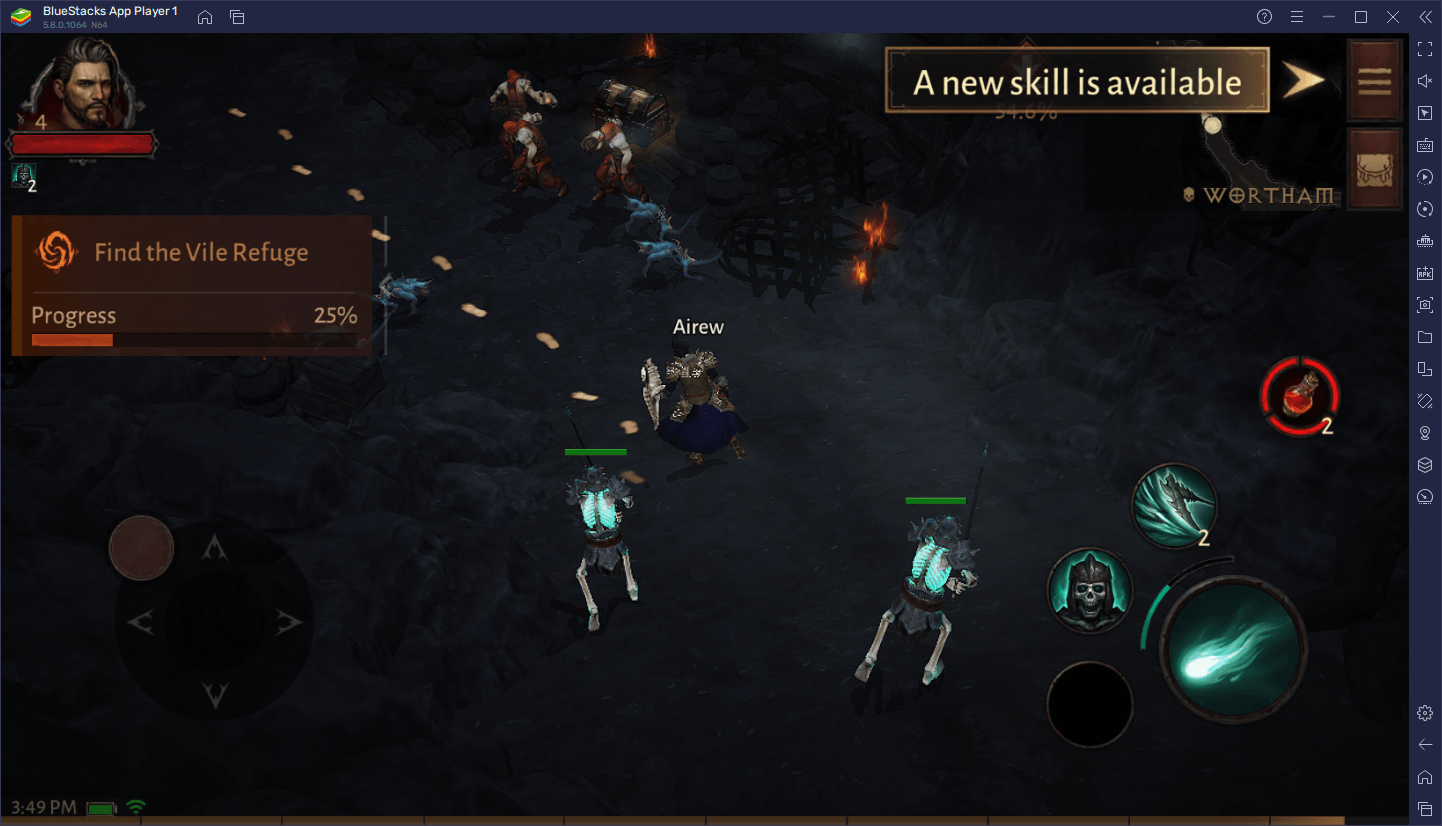
With that being said, we wanted to take this momentous occasion to share not only our impressions and that of the public to Diablo Immortal with a short review, but also to explain the fundamentals and basic aspects of this game, and everything you need to know to get a good start.
Keep in mind that, as a matter of comparison, we’ll be using images and screenshots from both Blizzard’s beta PC version of the game, and our version of Diablo Immortal on PC via BlueStacks. If you’re wondering why the screenshots look a bit different, this is why. Nevertheless, if you’re a Diablo Immortal beginner, or are simply wondering if this game is good and worth your time, then read on!
What is Diablo Immortal?
For many users, Diablo Immortal is the much-awaited fourth entry in the Diablo franchise, meant to give us another look into the ever-twisting chain of occurrences that transpire in the land of Sanctuary, as the Eternal Conflict between the forces of heaven and hell stirs restlessly in the background. For others, however, Diablo Immortal is that one game that didn’t need to happen and that, at best, is just a way to pass the time until Diablo 4, the “proper” mainline entry, releases.
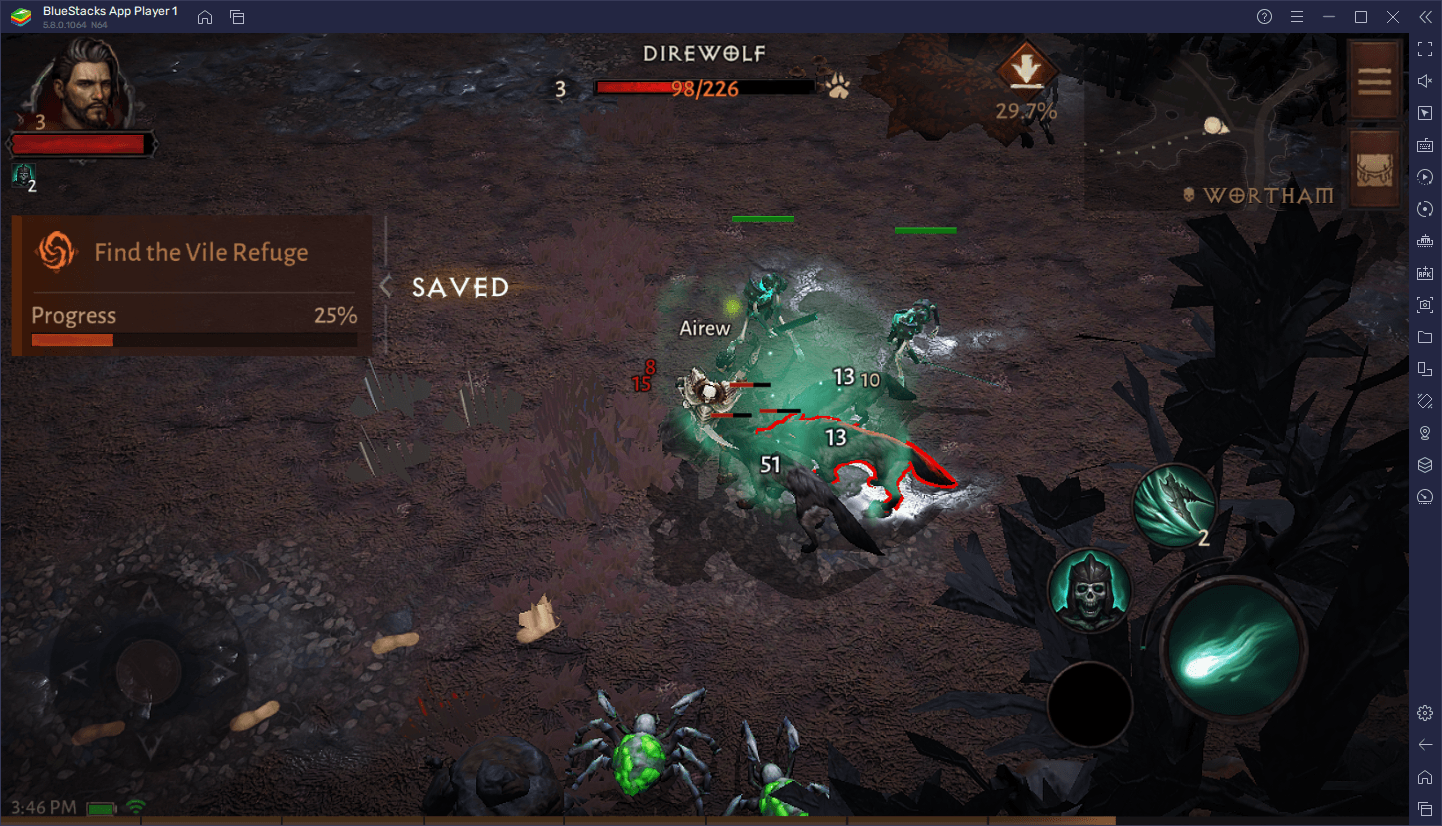
Regardless of your personal opinion on the concept of this game, Diablo Immortal was actually released, and as followers of the series ourselves, we can safely say that it’s definitely a worthy entry in the franchise. The main difference this time, at least compared to the previous Diablo 3, is that Immortal is an MMORPG. Whereas in the previous title players could freely drop into the matches of other users, players in Diablo Immortal all inhabit the same game world within the same server. In this sense, it’s possible to encounter other users as you go around completing quests and grinding mobs, and even grouping up to tackle harder content or to farm more efficiently.
In contrast to other titles in the series, Diablo Immortal wasn’t developed exclusively by Blizzard, but it was created in collaboration with NetEase, a mobile game development studio known for creating several iconic titles like Identity V, Marvel Super War, Rules of Survival, and Marvel Duel, among others. Despite this collaboration, however, Diablo Immortal retains the essence of the franchise, and feels right at home as another game in the series… for the most part.
If we had to mention some negatives here, it would be the fact that, like with Diablo 3, Immortal is an always-online game, with no way of playing offline. This means that, regardless of your connection speed and location, you’ll always have some latency, which isn’t overly bothersome, but it’s still there.
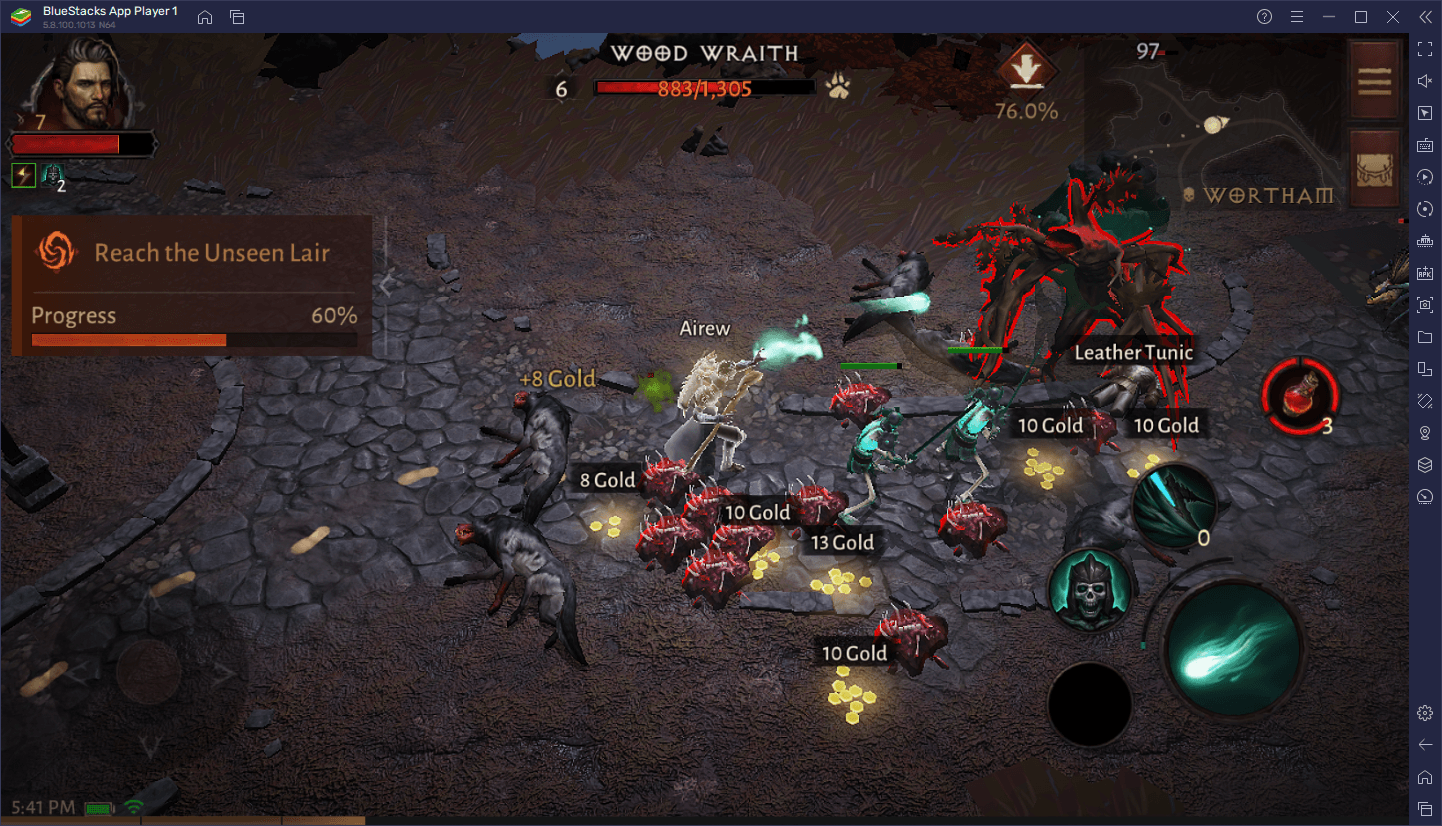
Secondly, and by far the biggest detriment to Diablo Immortal, is the endgame gearing system revolving around acquiring and upgrading legendary gems, a process that is excruciatingly slow, unless you pay real money to essentially speed up the process. And even if you decide to spend a bit, this won’t be enough, as you need LOTS of materials and items to actually make worthwhile progress in gearing yourself after beating the story content.
These negatives have no impact on Diablo Immortal for those who simply want to play through the game and experience the exciting battles and engaging story, even if you decide to play through it multiple times with different characters. They will, however, affect your experience if you want to get into PvP and minmax your characters.
How to Download and Play Diablo Immortal on PC
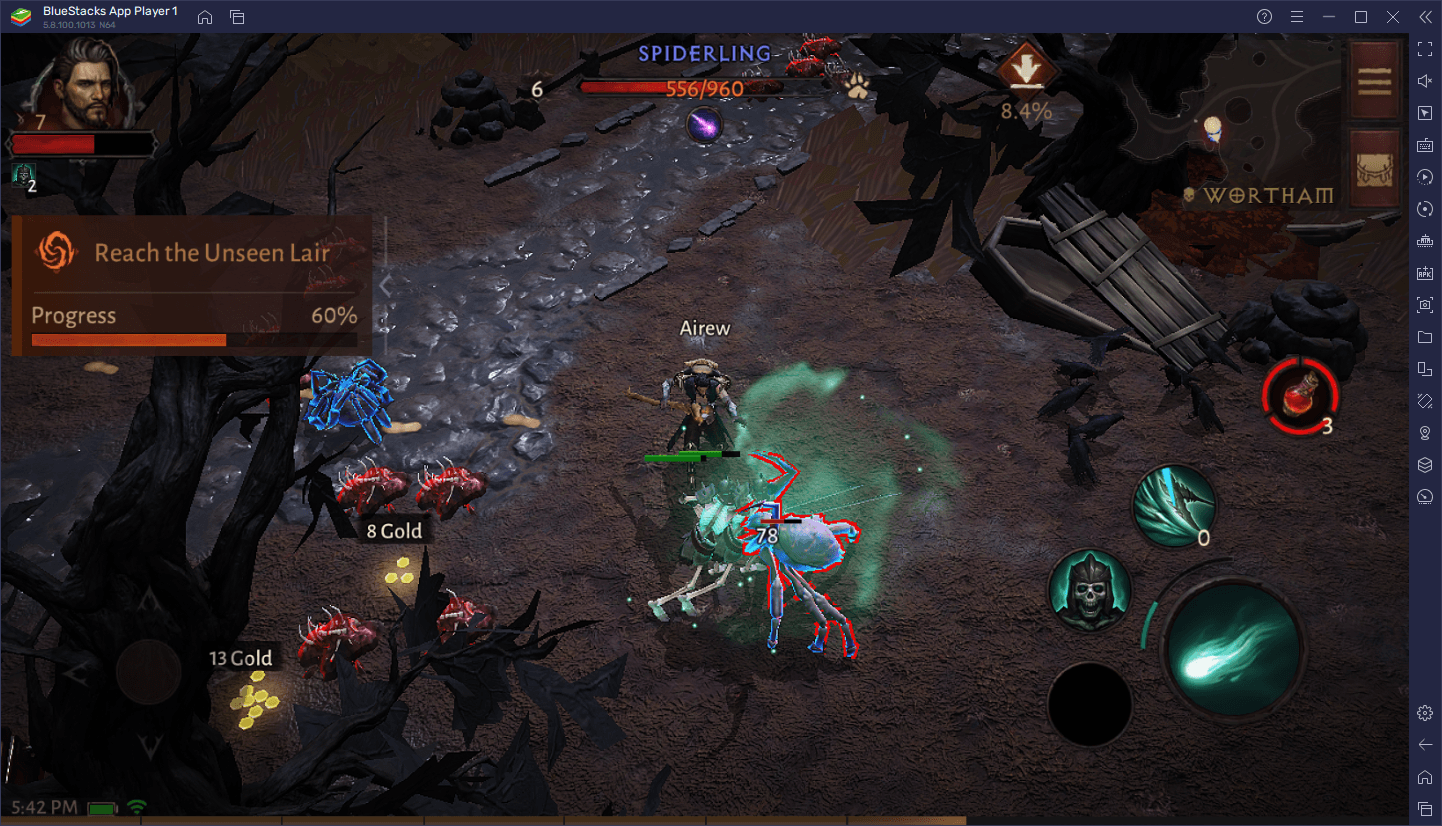
Diablo Immortal is the first mobile installment of the Diablo franchise. As such, users might encounter some issues with adjusting to the change in the control system and lack of space on the screen among several others.
However, by playing Diablo Immortal on PC with BlueStacks, you can enjoy Diablo Immortal to the fullest, even on low-end systems. Moreover, our Android App player has a variety of tools that you can use to enhance your experience with this game even further, such as the Macro Recorder through which you can automate some of the grind; the Instance Manager that lets you play on multiple accounts simultaneously, and more.
To install and play Diablo Immortal on PC with BlueStacks, you simply need to follow these simple steps:
- On the BlueStacks website, search “Diablo Immortal” and click on the relevant result.
- Click on the “Play Diablo Immortal on PC” link on the top left.
- Download and install BlueStacks on your PC.
- Click on the “Diablo Immortal” icon at the bottom of your BlueStacks screen.
- Complete the Google Sign-in to install the game.
- Click the “Diablo Immortal” icon on the home screen to start playing.
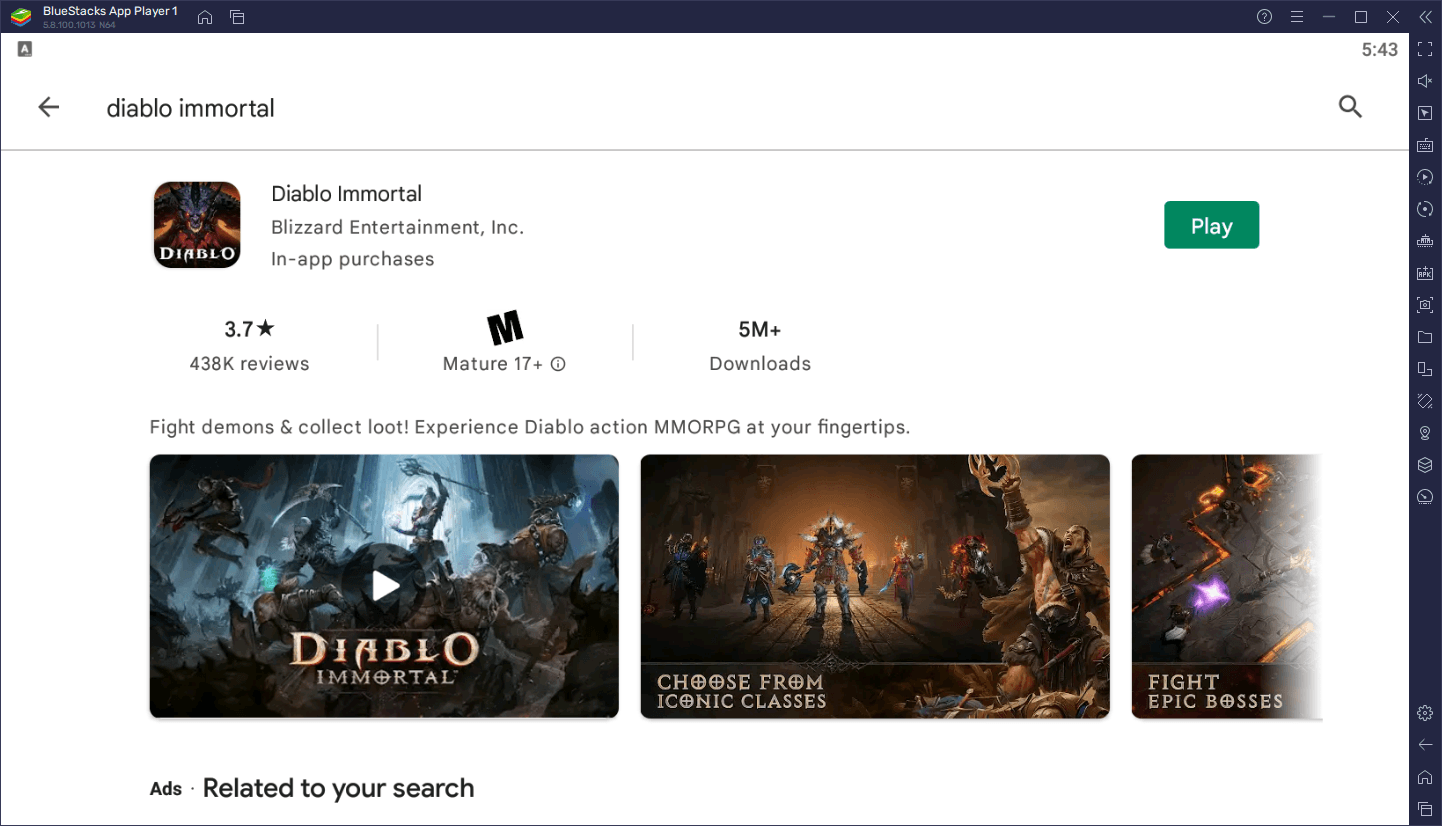
Once you are done with the entire process mentioned above, you’ll be able to enjoy this awesome game on your PC. The difference here is mainly our accessibility to users with low-end systems. However, we’re positive that the tools and features that you can find on BlueStacks may also dramatically improve your results in Diablo Immortal.
The Story and Setting in Diablo Immortal
Admittedly, while the lore in the Diablo series is rich and interesting for some users, this is far from being the main appeal of the games for the majority of gamers. Nevertheless, Diablo Immortal is chock full of narrative elements, without getting overly plot-heavy, striking a nice balance between cutscenes, narrative segments, and gameplay.
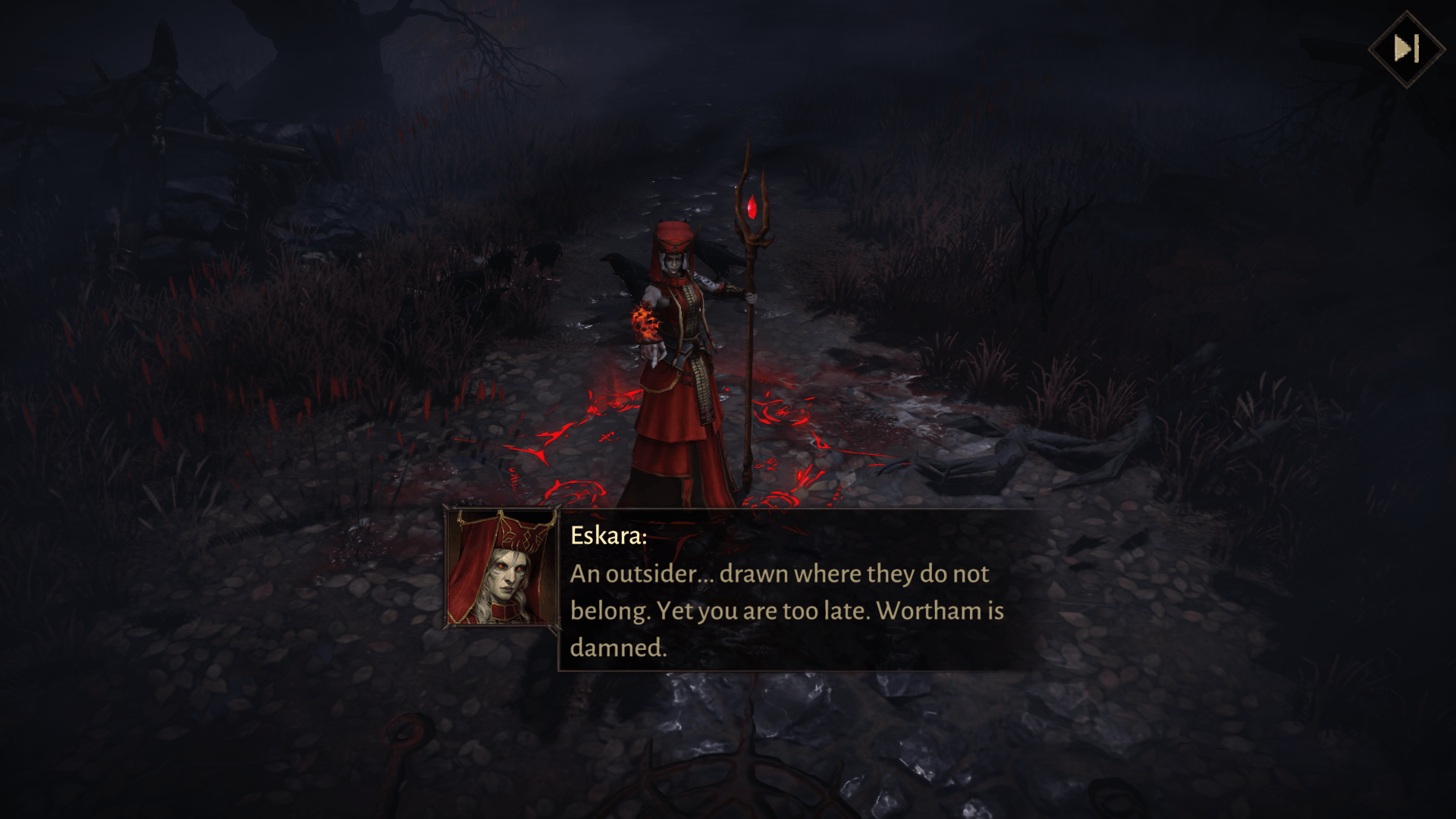
Immortal is set between Diablo 2: Lord of Destruction and Diablo 3, five years after the climactic battle against the Prime Evil, Baal, and the destruction of Sanctuary’s Worldstone by the Archangel Tyrael. Even though it lay destroyed within the Pandemonium Fortress in Mount Arreat after it was corrupted by the Lord of Destruction, several shards of the Worldstone broke off in the impact and were scattered around the world, corrupting everything they came into contact with.
Five years later, strange occurrences started manifesting all over Sanctuary, with hordes of demons, cultists, and undead suddenly appearing and attacking the populace. Our journey starts after choosing our class and landing in the outskirts of Wortham, where the events of the game will start unraveling before us.
Diablo Immortal Basic Gameplay
If you’ve ever played a Diablo game before—Diablo 3, in particular—you’ll probably already be familiar with everything you can expect from Diablo Immortal. The reason we mention Diablo 3 over the others is because Immortal is actually quite similar, both in the flow of its gameplay, as well as its visuals, which is why we mentioned earlier that folks online describe it as “Diablo 3 Lite”.
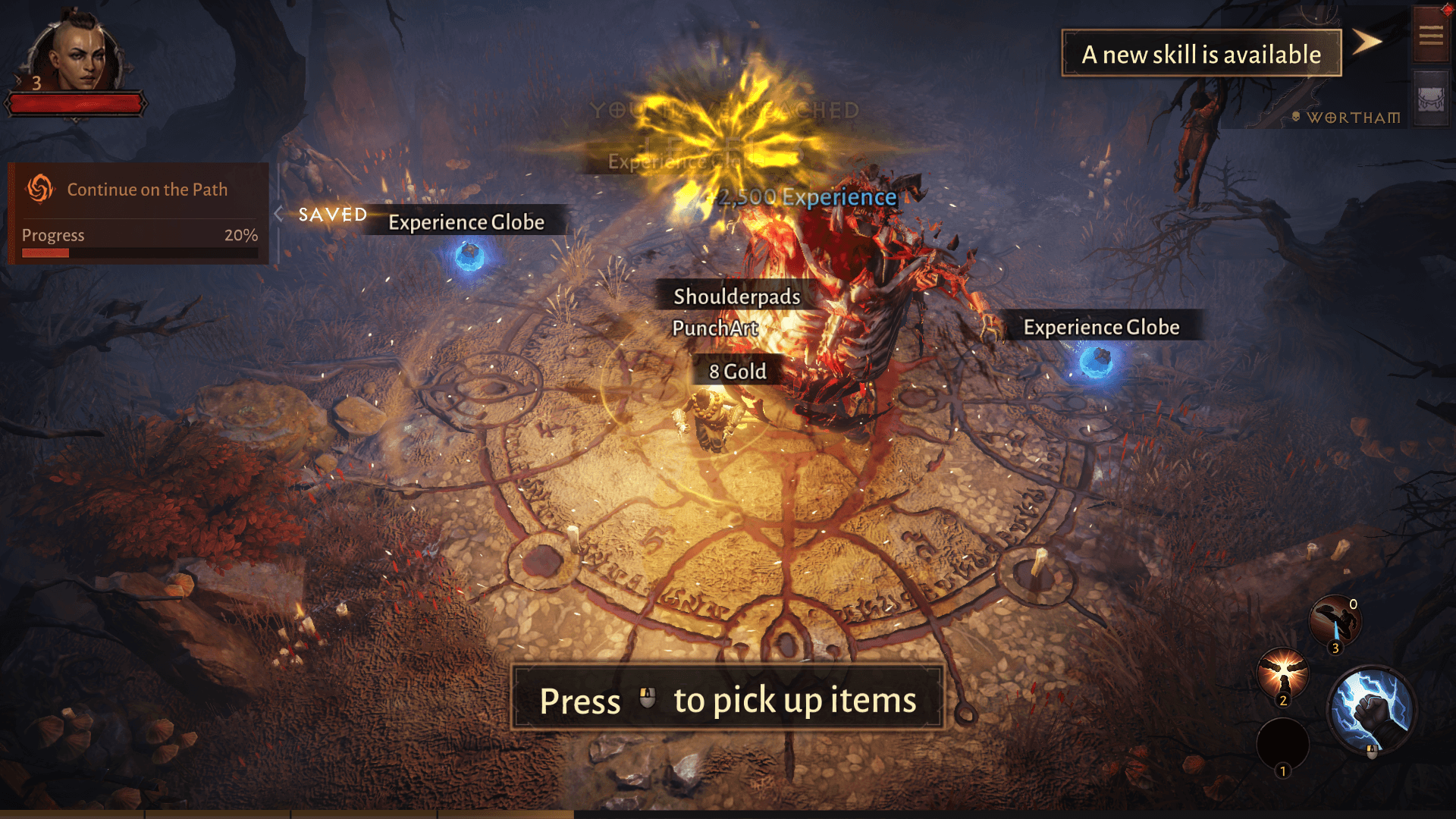
Now, this similarity is in no way a bad thing. In fact, we consider that, while they are similar in general gameplay; Immortal has more snappy and punchy gameplay, with its animations and effects tweaked to appear more impactful and the combat smoother than ever. If anything, we feel like we’re actually playing an enhanced version of Diablo 3, which is awesome, to say the least.
Initially, the game is quite story-heavy as it introduces us to the world and current events, and as the player progresses through the introductory quests. However, after finishing the tutorial and joining the general game world where other players are running around, it immediately picks up speed as you’ll be traveling across countless different locations completing quests, defeating monsters, looting gear, and continuously pulling on the threads to unravel the game’s story.
The combat in Diablo Immortal is your standard hack-and-slash experience: You click on the enemies to make your character attack with their basic skill, and you also have up to four skill slots in which you can equip different abilities. On top of that, as you gain experience from completing quests and defeating monsters, your character will level up and learn new skills. However, as we just mentioned, you can only equip a maximum of four of these at any given moment, which essentially makes up your “build”. In this manner, while you may encounter two players of the same class, their play styles might be radically different depending on their skill sets.
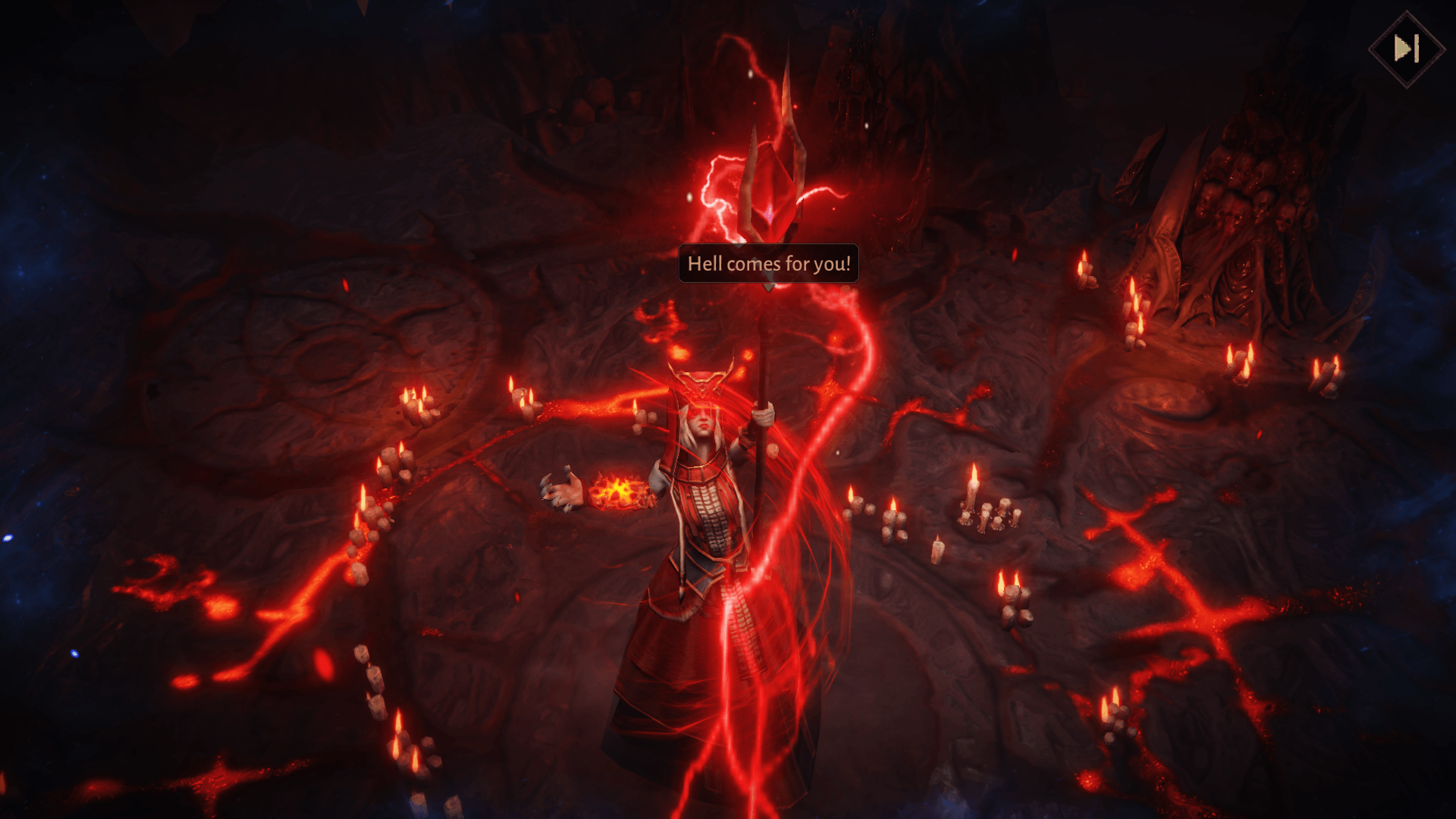
The general gameplay loop in Diablo Immortal once you reach the endgame is where the game breaks down, since it’s not just a matter of running dungeons to collect gear, but of optimizing your stats and skills by acquiring legendary gems. And while these items are not necessary to clear through the main story, they will become vital for your success and survival in the high-end PvP game modes. Regrettably, it takes an exorbitant amount of time or, if you’re the type of player who likes to spend money in games, an enormous amount of cash to max out just one character, which is enough to dissuade all but the most committed players from doing so.
Diablo Immortal Servers
Diablo Immortal is an online MMORPG, which means that players will need to connect to servers in order to play. Interestingly enough, there is a very, very large variety of servers to choose from, which are divided into five different regions: North America, South America, Europe, Oceania, and East Asia. Moreover, each region has a variety of servers, some of which can be in different timezones, as shown on the server list before you log in.
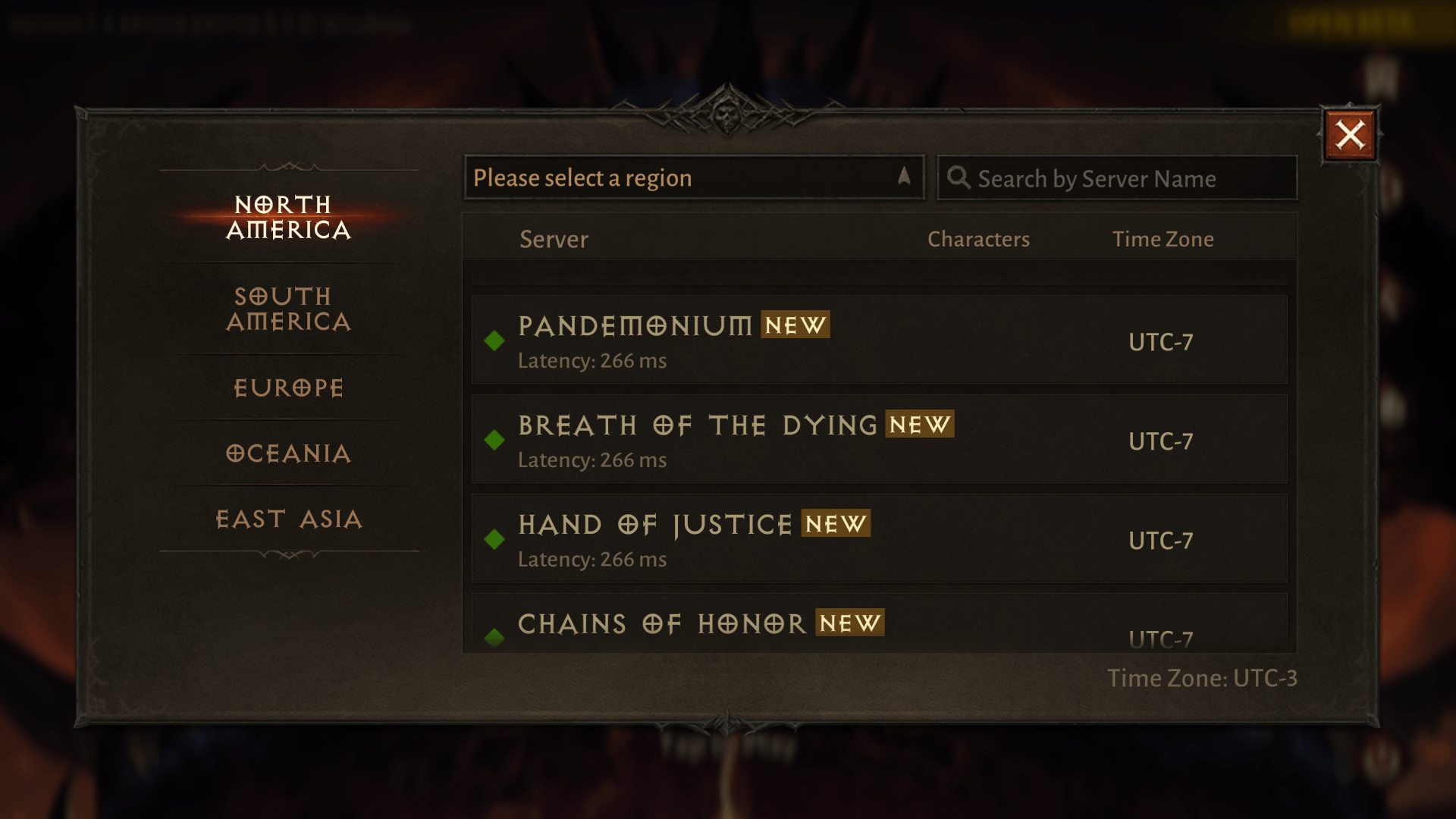
Ideally, you would choose to connect to not only your current region to reduce server latency, but to a server that’s closest to your timezone. This will ensure that you will be playing at around the same times as other players, giving you better chances of meeting new people and finding teams for group content. However, it’s worth noting that, once you create a character in a server, they can’t be transferred to another server in any way. Additionally, while Diablo Immortal has crossplay between its mobile and PC versions, players can only ever meet up with other users in their own server.
Aside from what we mentioned here, the only real difference between servers in the same timezone is possibly their population, as well as the server name, which in itself has no bearing on the gameplay.
Keep all of this in mind when choosing your Diablo Immortal server.
Diablo Immortal Classes
One of the most entertaining aspects of the Diablo series is the fact that you can choose multiple classes and slowly discover everything they have to offer as you level up. Additionally, this also gives the game a lot of replay value as you can complete it multiple times using different characters, and get a different experience on every run.
In this regard, Diablo Immortal is no exception as it gives players the option to choose between six different classes:
- Barbarian
Strong, sweeping strikes with a variety of weapons and brute force make up the brunt of the kit that the Barbarian offers. This class is ideal for those who enjoy brutally rushing enemies on the battlefield.

- Wizard
Wields a variety of elements and arcane energies to vaporize their enemies. They specialize in dealing sustained burst damage, but can also mow down hordes of enemies with AoE spells.
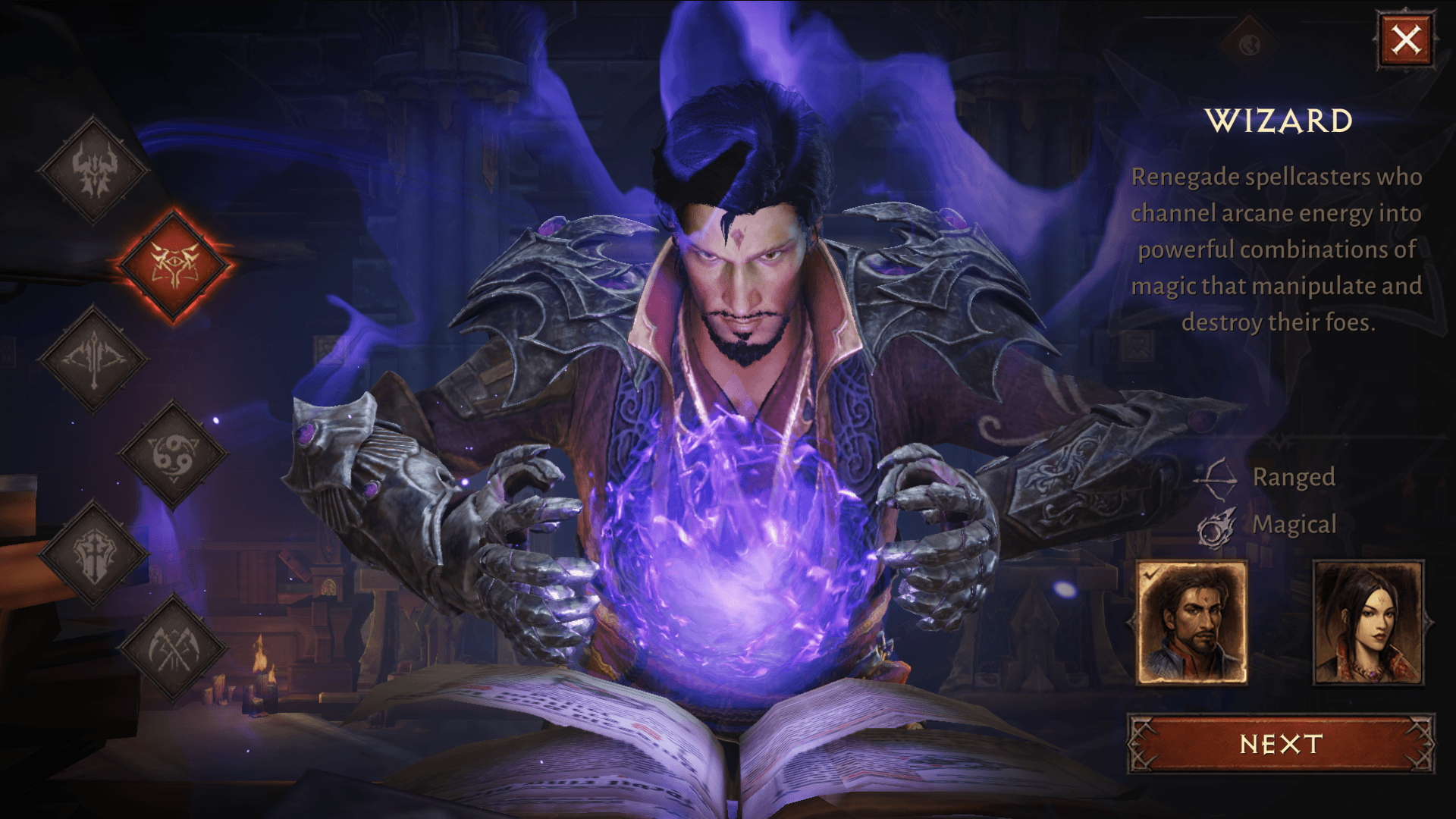
- Demon Hunter
A specialist at taking down dangerous enemies with an assortment of deadly skills. The Demon Hunter strikes from afar with pinpoint precision, and is great for taking down bosses and other dangerous threats.
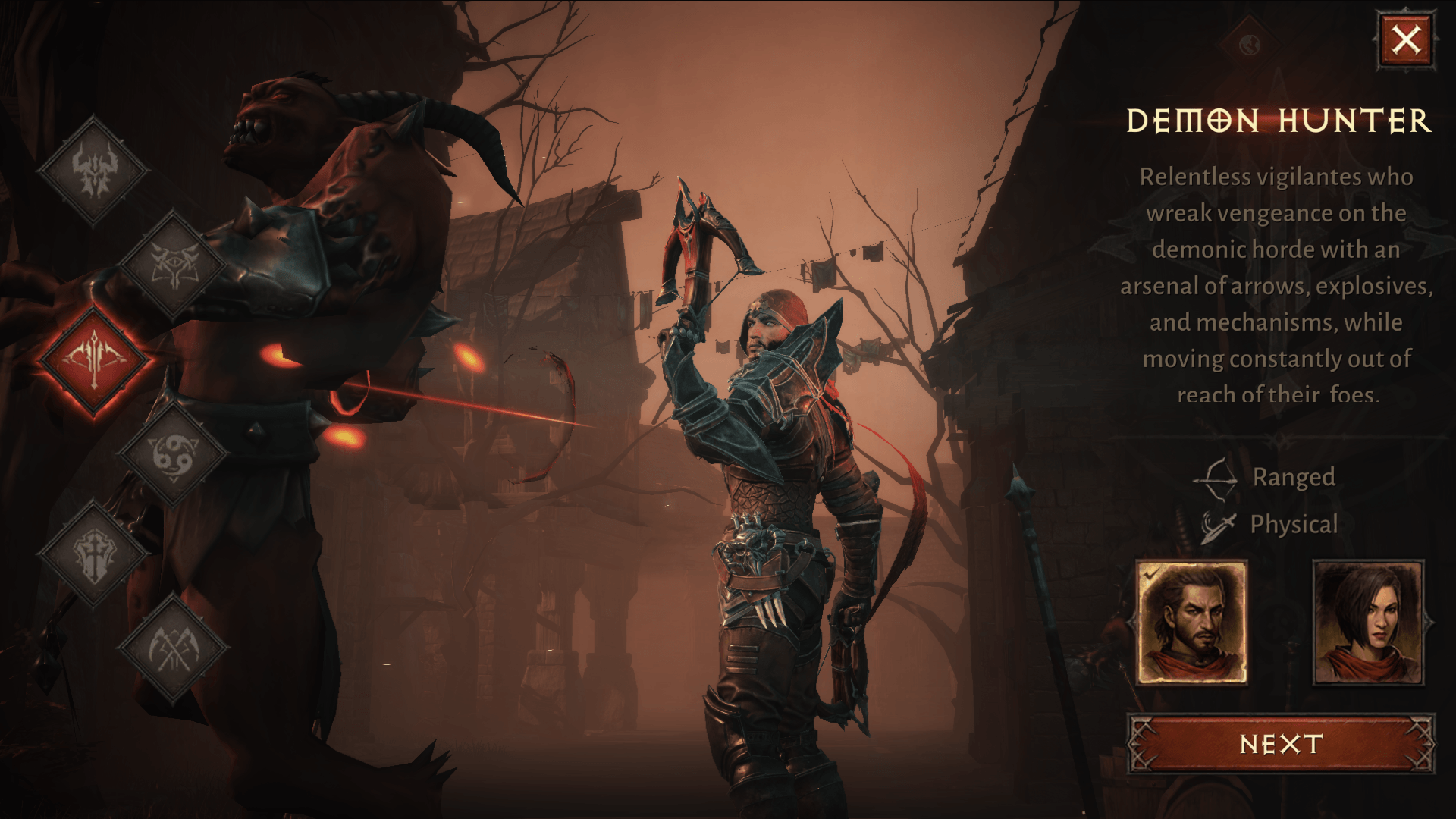
- Crusader
Donning their massive armor and even bigger shields, Crusaders march into battle with the power of the light on their sides, smiting all enemies in their way. This highly defensive class is ideal for beginners since they’re quite resilient and allow for making many mistakes.
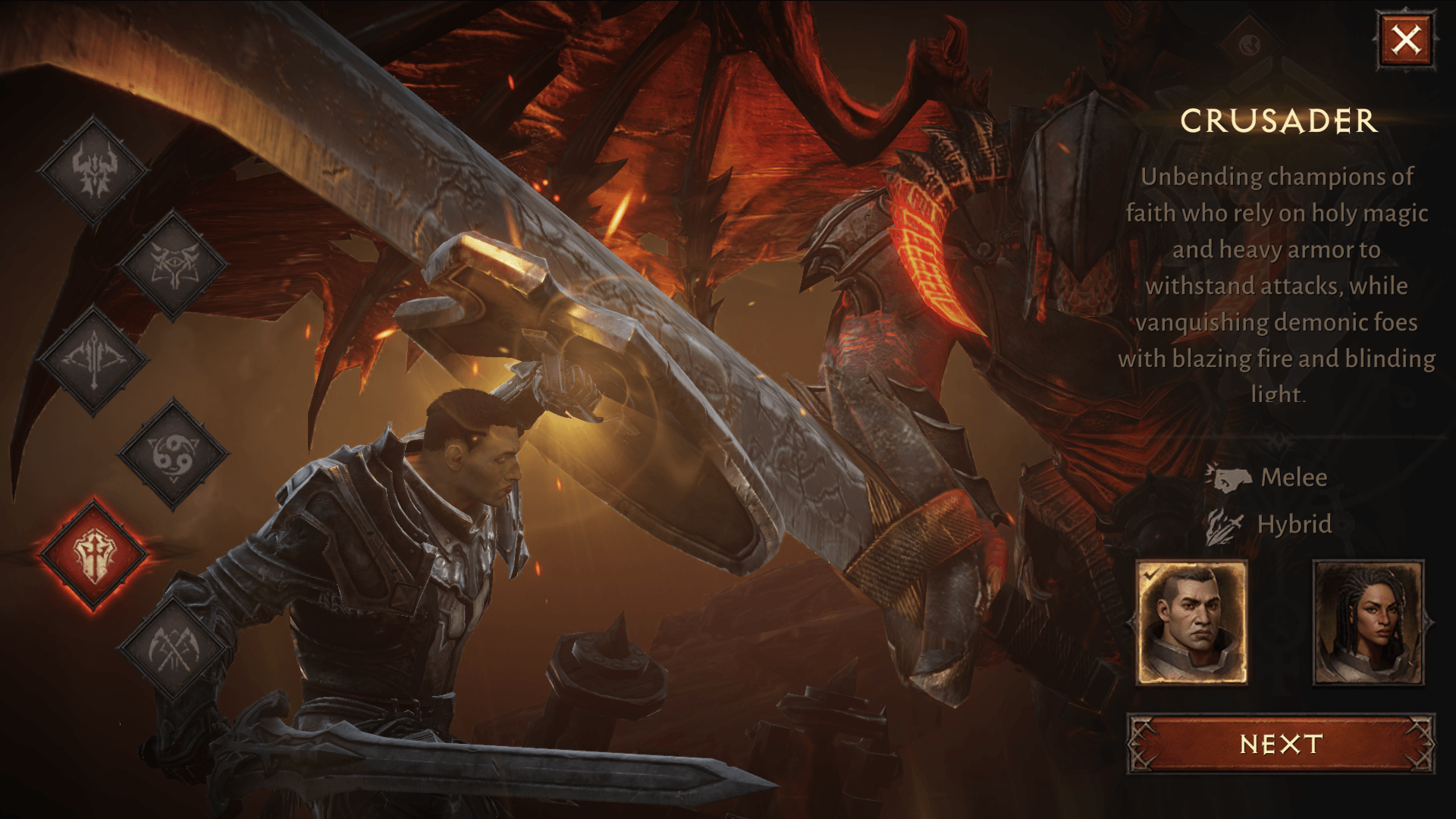
- Necromancer
A fearsome spellcaster that can raise an army of undead minions to fight in their stead. However, when encountered on their own, Necromancers can also throw deadly curses and use a variety of bone-based spells to destroy their enemies.
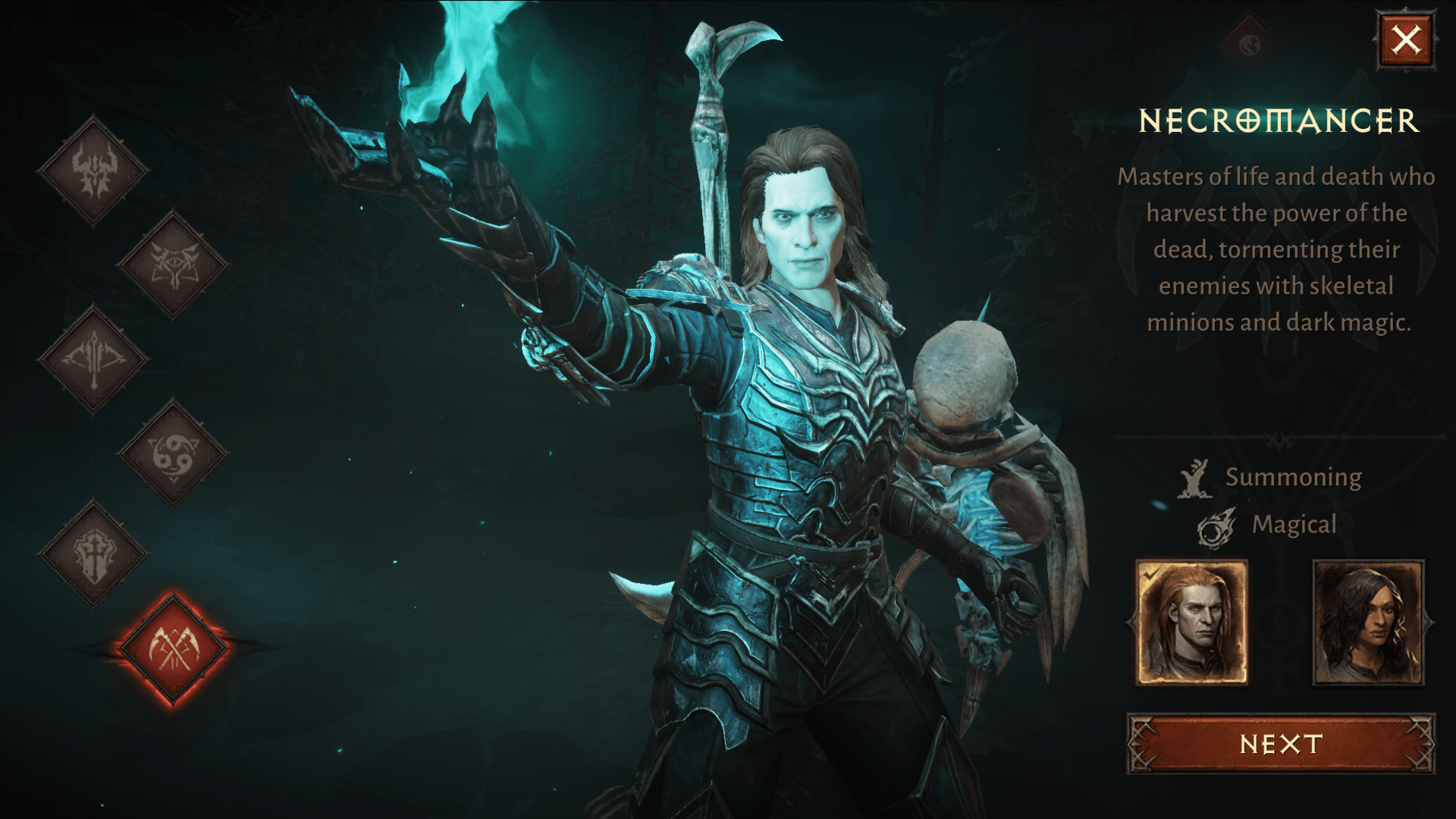
- Monk
Powerful fighters who use their entire bodies as weapons to eliminate anything that stands in their way. Monks are speedy fighters that can jump in and out of combat with dashes and sweeping strikes that can automatically close the distance to their foes.
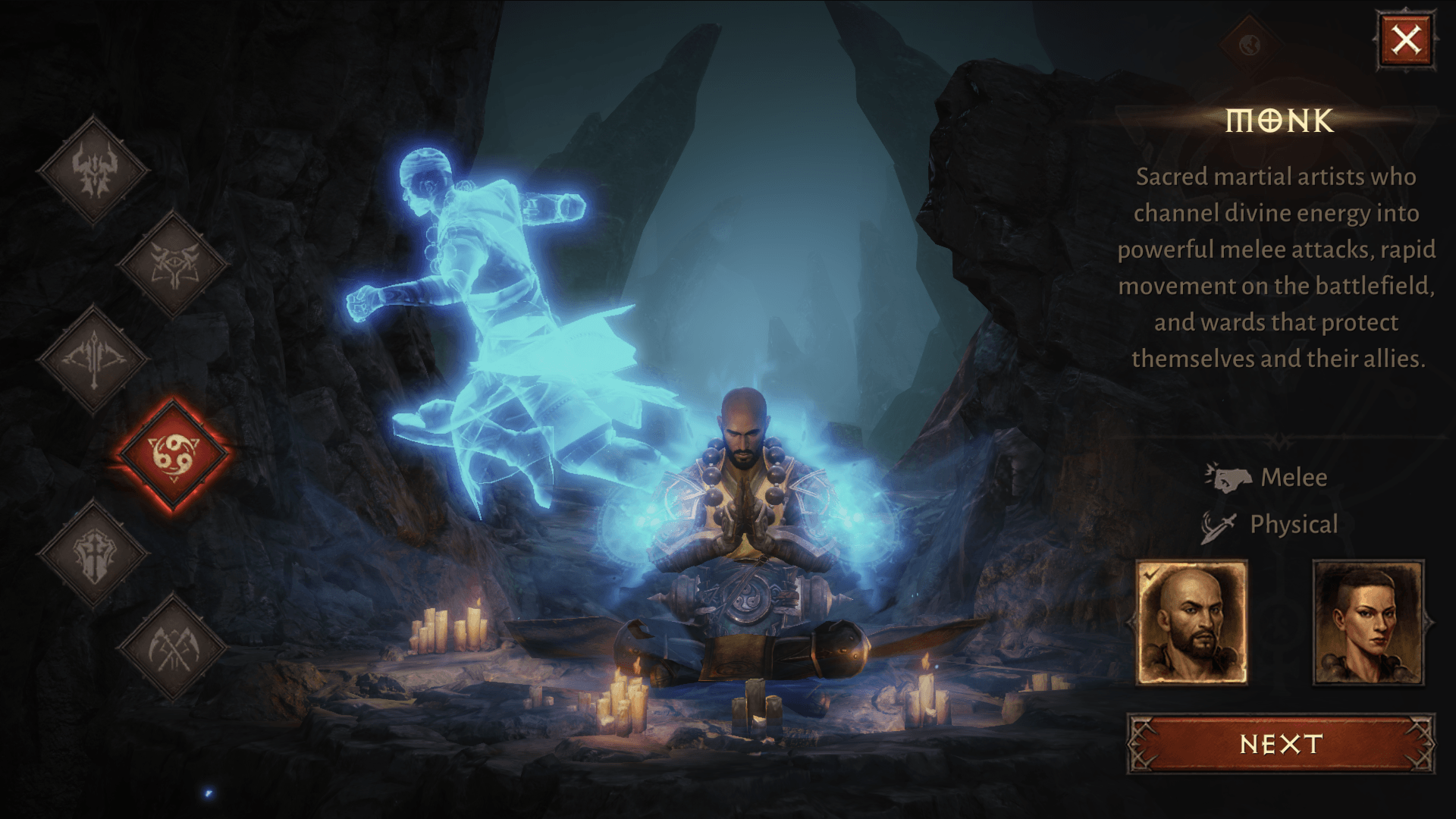
Regardless of the class that you choose, they are all capable of utterly destroying their foes and completing the story on their own. The important thing here is that you choose the class that meshes the best with your preferred play style.
The Skill System in Diablo Immortal
While each class looks and plays differently from each other, these differences actually stem from the skills that they learn as they level up. After all, regardless of the class that you choose, you’ll still always auto-attack your enemies in a similar fashion if you left-click on them. However, your gameplay and approach to combat will change dramatically depending on the skills that you equip.
The skill system in Diablo Immortal is quite simple and straightforward: As you level up, you’ll unlock additional skill slots, up to a maximum of four at level 8. Similarly, increasing your level will also allow you to unlock a wide variety of skills for your class, each with their own effects and uses. However, since you can only equip a maximum of four skills at any given moment, there can be countless different ways of playing any given class.
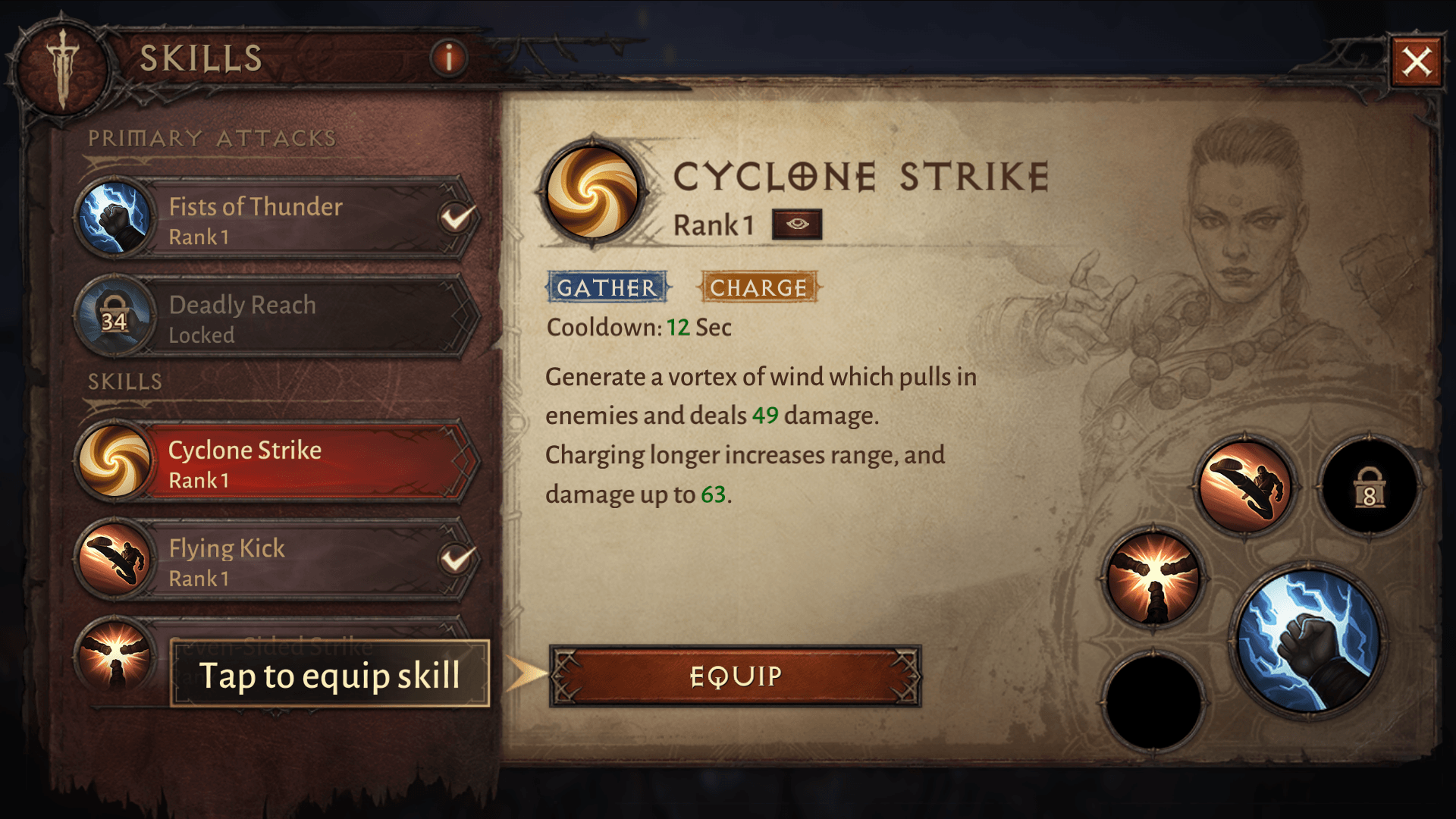
One important aspect to know about skills revolves around your primary attack, which is essentially your auto-attack in this game. There are only two of these skills per class, and each of them has an ultimate effect, which you can use once the ultimate gauge is completely charged. This gauge charges up automatically as you hit enemies with your primary attack, and when used, can usually bestow powerful effects and buffs.
Gearing in Diablo Immortal
Just like in other Diablo games, gearing up is an important aspect of Diablo Immortal.
As you defeat minibosses, elites, and other powerful enemies, they can drop gear and weapons of varying rarity, which go, in ascending order of quality, as common, magical, rare, set, and legendary items. The most powerful items not only often have better base stats than their more common counterparts, but can also grant special effects to the wearer. In fact, some legendary items can even modify the effects of certain skills, changing their behavior and functionality.
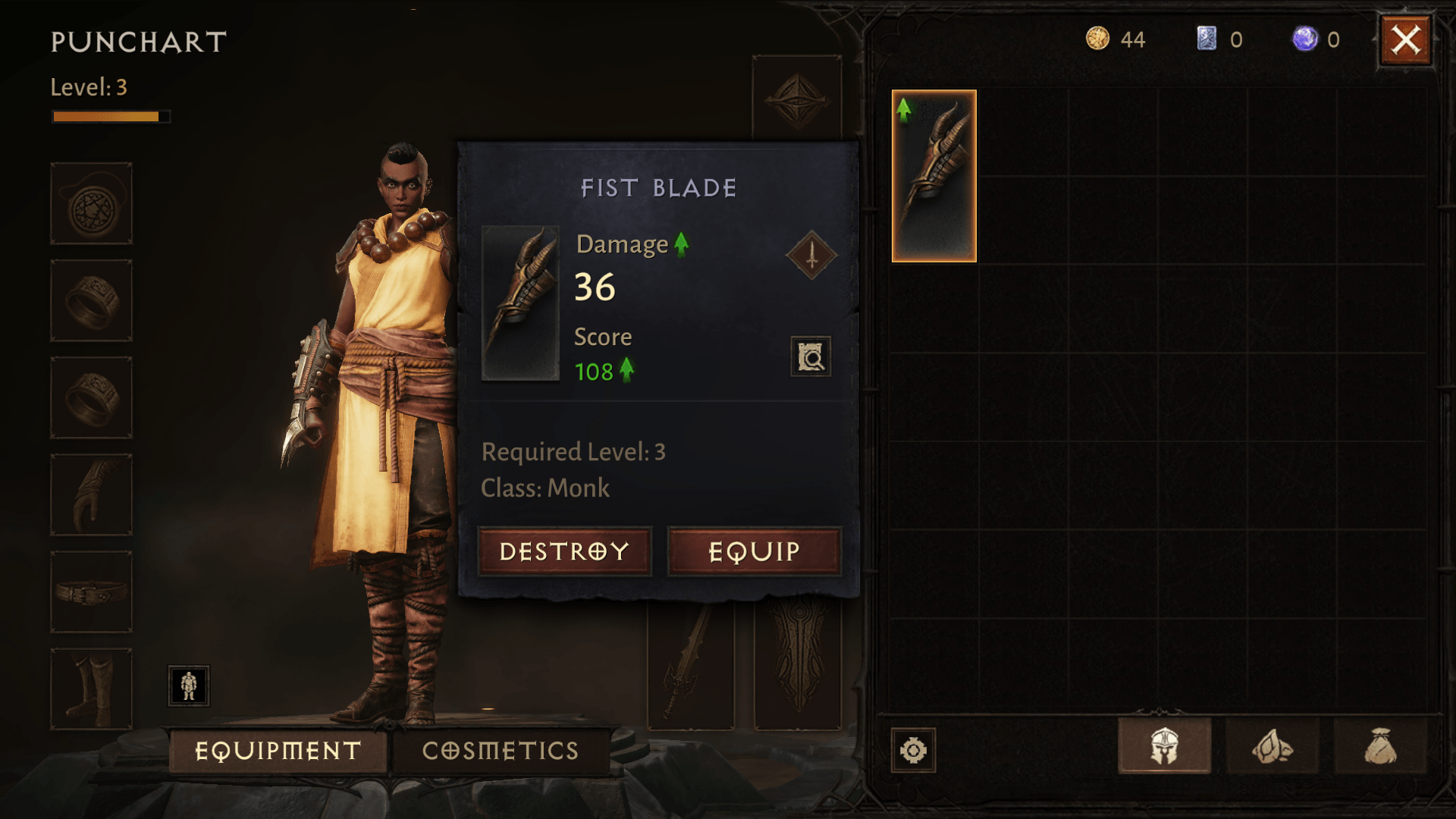
Aside from collecting gear from enemies and bosses, you can also visit a blacksmith to upgrade your best pieces, which will in turn increase their stats, making them much stronger and valuable. And the best part about this upgrade system is that all these enhancements can be freely transferred to other pieces. For example, if you have some nice upgraded legendary bracers, but find a better pair of bracers, you can simply swap them in for your old ones, and transfer the existing upgrades to the new ones. These transfers also apply to sockets and gems, since you can also freely move gems to new pieces of gear.
The key to becoming stronger in Diablo Immortal, aside from leveling up, is keeping your equipment properly upgraded. However, to achieve this, you’ll need to farm gold, as well as scrap materials, which are obtained from completing missions and challenges. And in the case of the latter, you can also find these from breaking down your unused gear through the salvage option at the blacksmith.
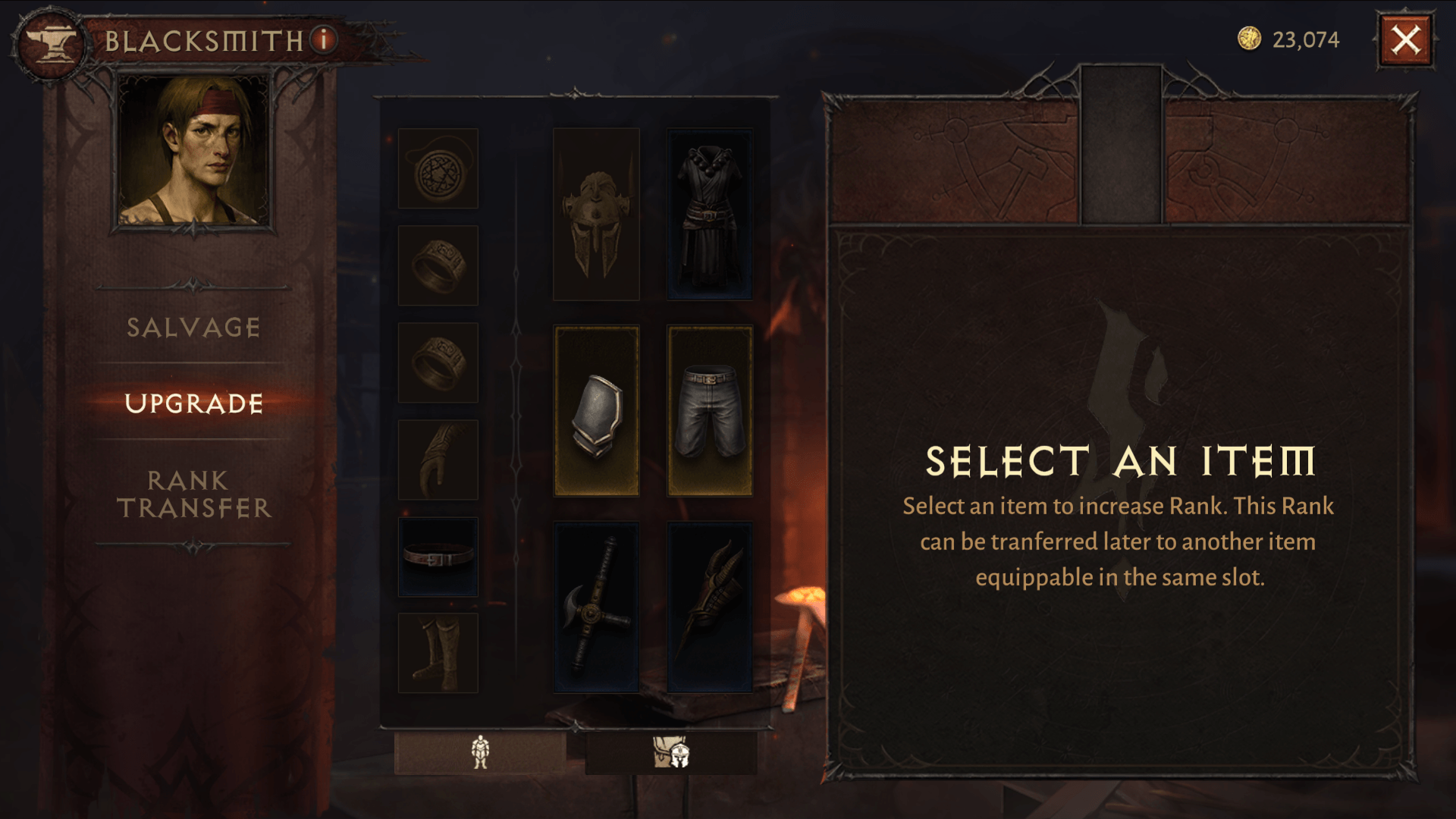
Finally, it’s worth pointing out that only rare, legendary, and set items can be upgraded. Additionally, the maximum rank of any given piece will vary depending on its rarity, with rares having a cap of 5; set items a cap of 10, and legendary items a cap of 20. It goes without saying that the best items in the game will often be legendaries, which are also the hardest to find while hunting.
Diablo Immortal Reviews and Ratings
Despite its successful launch with over 5 million downloads on the Play Store only a week after its launch, and presumably a significant number of users on the PC version as well, Diablo Immortal was met with lukewarm reception, mirroring the moment when it was revealed back in 2018. This is mostly apparent by the over 400 thousand user ratings on the Play Store that gave the game an average rating of 3.3 stars, which is shockingly low for a game belonging to such a significant franchise.
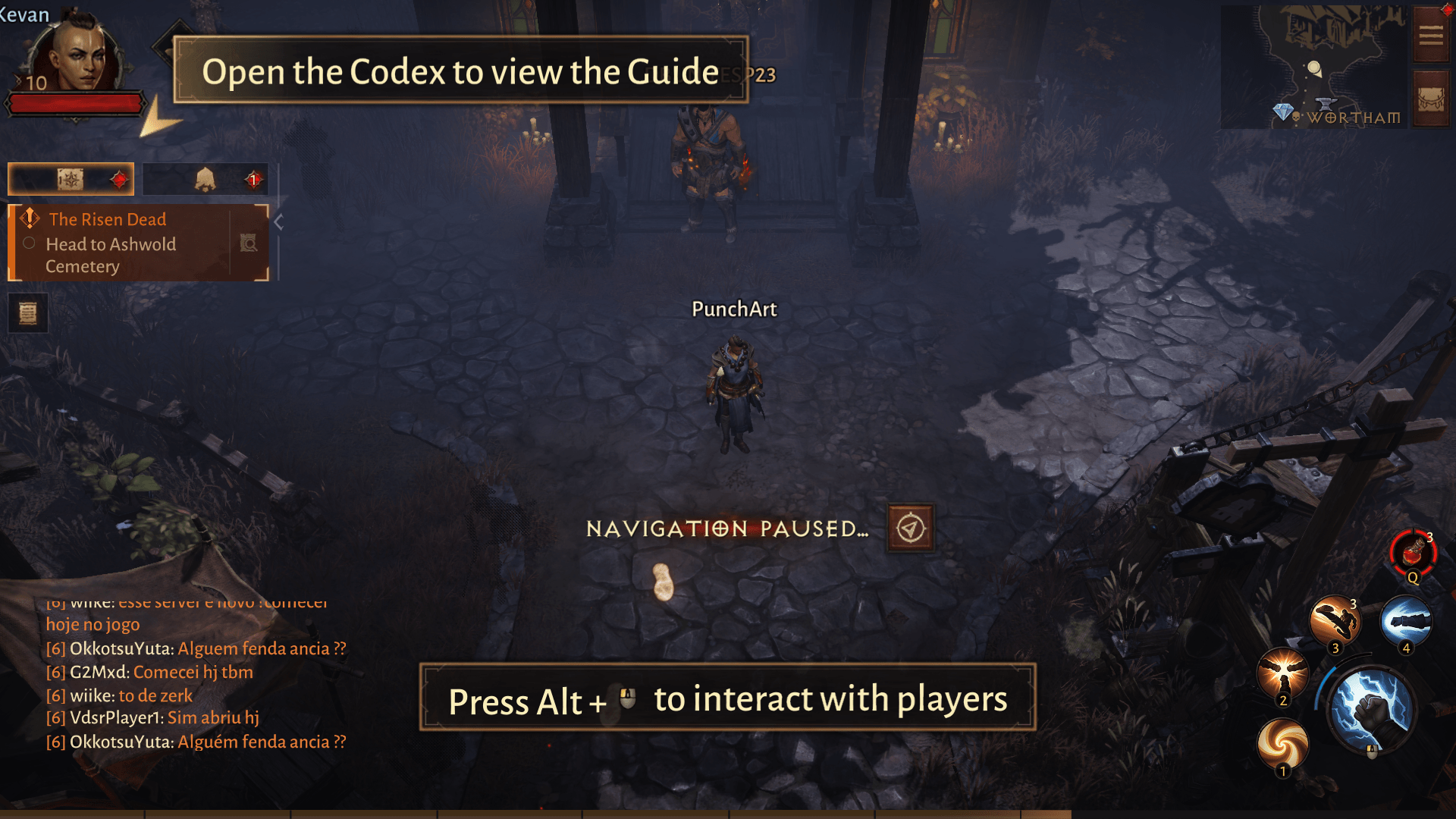
It’s quite clear that the crowd is split right down in half with this game, considering that there’s around a 50/50 split between 5-star and 1-star ratings:
On the one hand, the positive reviews praise the game for its excellent combat system and graphics, which we personally agree with. The team at Blizzard and NetEase have created something the likes of which is rarely seen on the mobile platform, which is a game that looks and plays just as smoothly as its predecessors on PC and consoles.
On the other hand, most negative comments stem from the game’s heavy-handed business model, where players who want to optimize their characters (within their lifetimes) would have to spend a lot of money on buying cash shop items that would give them a small chance of obtaining the best gems in the game. And of course, just like with any other business model that revolves around playing exorbitant sums just to get the smallest chance of receiving the items that you need, the audience didn’t let this slide.
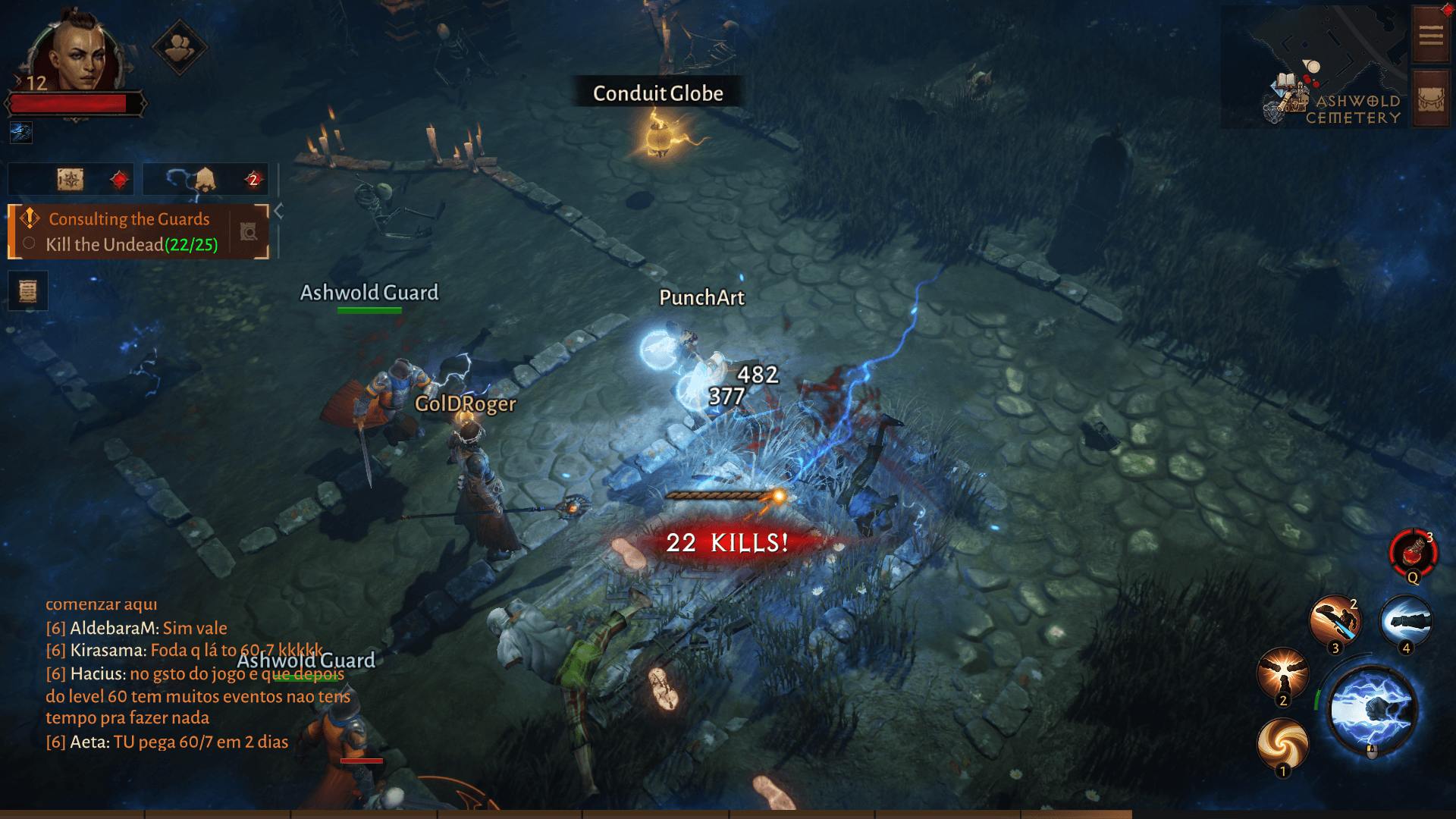
This problem is further compounded by the fact that Diablo Immortal is a game belonging to a beloved franchise that, for the longest time, had nothing to do with these monetization features. And while Diablo 3 launched with an atrocious in-game marketboard that encouraged real money trading, they eventually patched it out after the huge public backlash.
You’d think they learned the lesson after Diablo 3, but it seems that Blizzard is in for another public beating with Immortal.
Nevertheless, we can wear our hearts on our sleeves and say that Diablo Immortal is by no means a bad game. This is some of the most fun we’ve ever had with an action game on this platform: the action is fast and satisfying; leveling up and discovering new skills is interesting; trying out new classes adds a ton of replay value, and it’s just generally a good time to kill a strong boss and watch all those yellow and orange drops pop out like a piñata.
Moreover, the problem with these legendary gems really only applies to you if you’re thinking of getting into the PvP and competitive endgame content, which you’re obviously entitled to. And in this case, you’d be quite vindicated to be disappointed with the devs in this regard. However, those who are interested in getting the PvE Diablo experience will likely have tons of fun with this game, especially if they play it together with friends.
Legendary Gems and the Issues They Bring
It’s apparent that the fears of the skeptical Diablo crowd are all but confirmed, considering that Diablo Immortal is considered by countless users to be unequivocally pay-to-win, with a predatory business model that, according to user reports, requires players to pay over $100k to max out a single character. This is due to the fact that, in order to optimize any given character, players need to farm legendary gems, which are only obtained at a very, very low rate after completing Elder Rifts. However, by using Legendary Crests, a cash shop item, when opening an Elder Rift, players are guaranteed to receive a legendary gem when defeating the Rift Guardian.
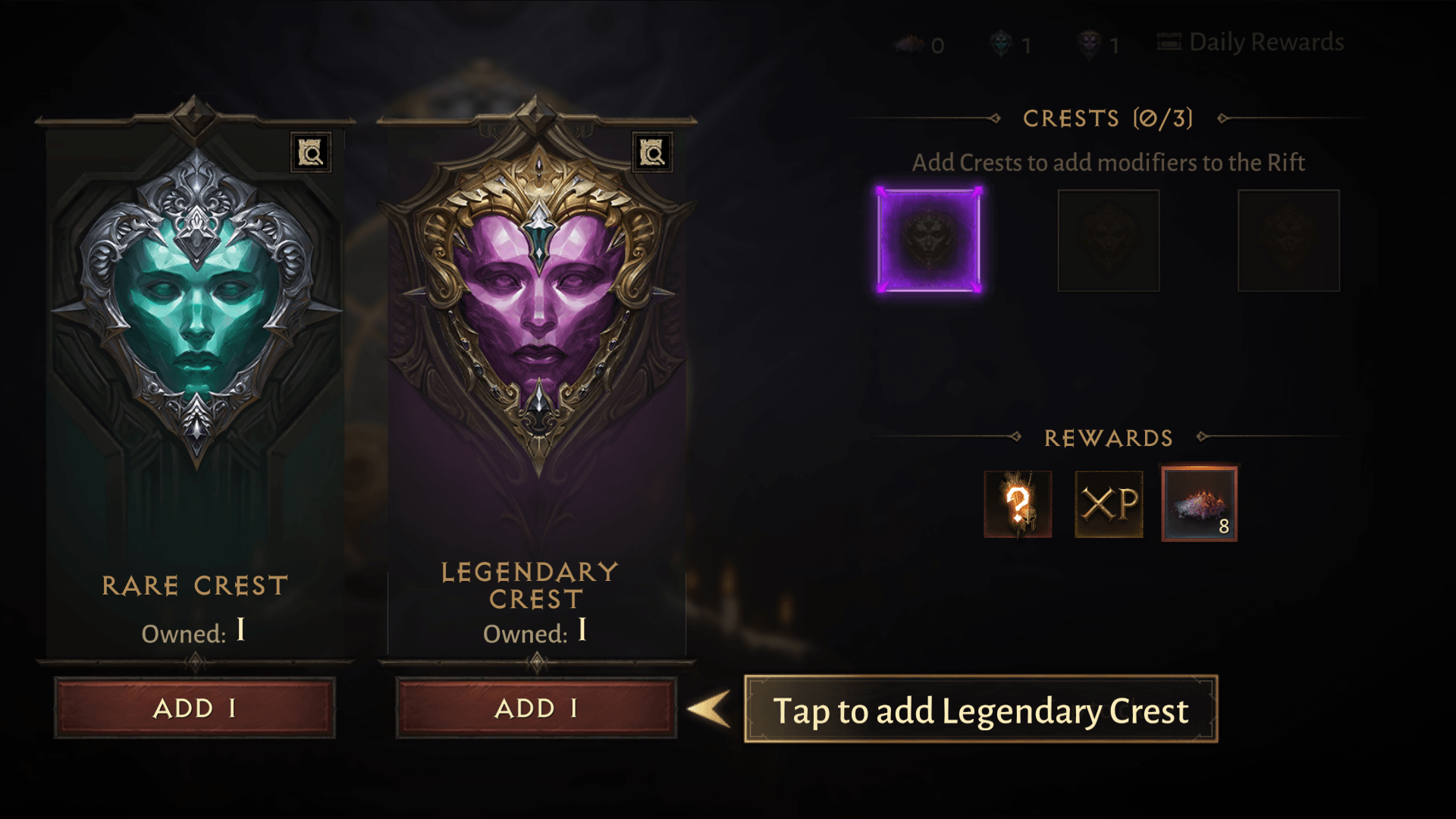
Sadly, the problems with these gems go beyond simply obtaining them, since you not only have to worry about getting the right gems, but to get them in the right rank. This is because legendary gems can come in a random rank cap, from 1 to 5 stars, where the best ones are obviously the 5-star variants. In this sense, while you’re guaranteed to get a legendary gem when using a Legendary Crest, the odds of getting a 5-star variant is only 4.5% per drop. And as if that wasn’t enough, even if you DO get a 5-star legendary gem, these come at a randomized base rank, also from 1 to 5, with the best ones being the elusive 5/5 legendary gems.
So, to sum it up: In order to minmax and optimize your character, Diablo Immortal expects you to spend money on Legendary Crests, which are used for getting a guaranteed legendary gem when completing Elder Rifts. However, these gems have only a 4.5% chance of being a 5-star variant. Moreover, these 5-star variants only have a 1% chance of being a 5/5. With these odds, it’s no wonder people are reporting such high prices to minmax a character in this game.
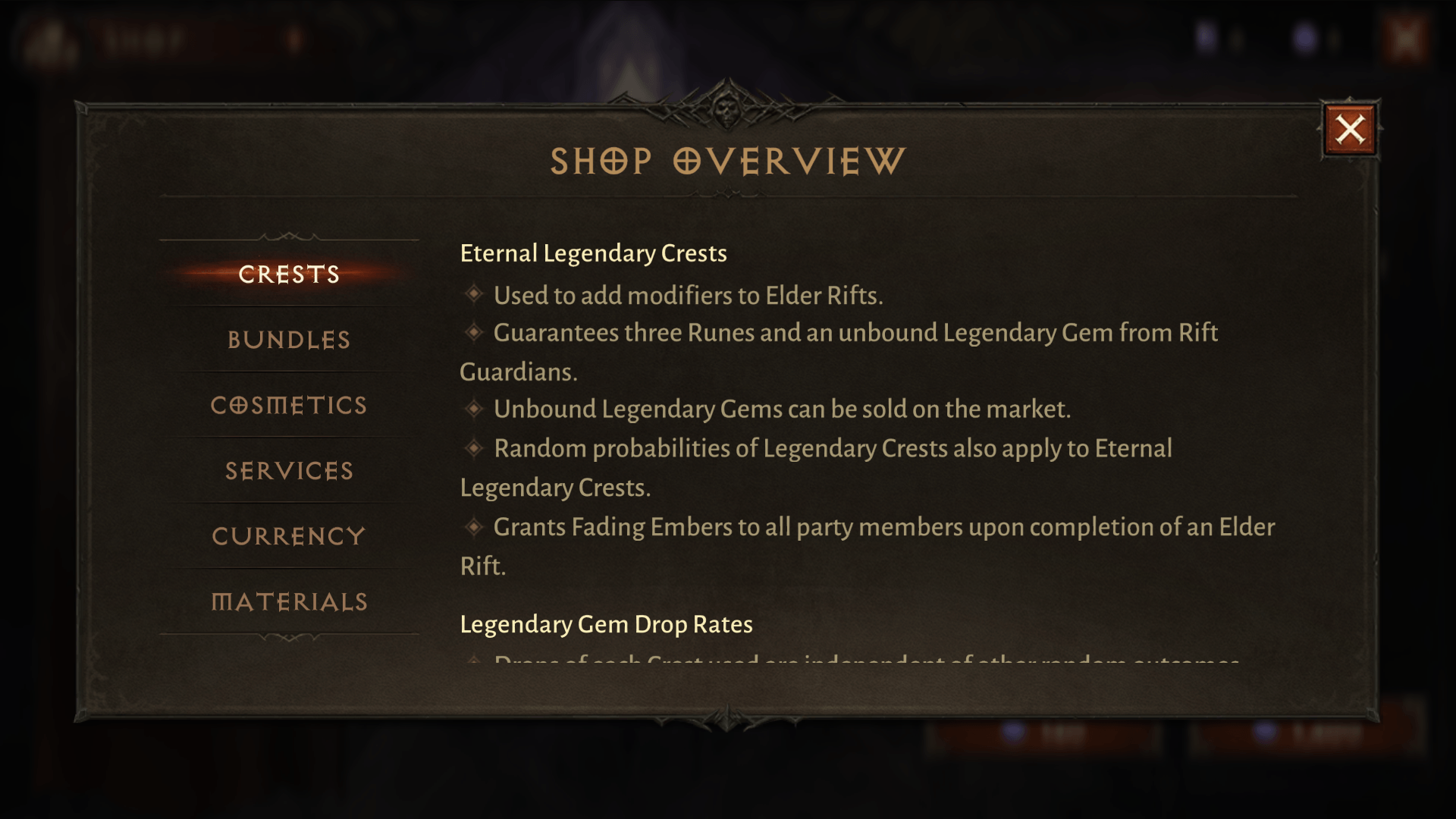
As a consolation prize of sorts, Blizzard has a pity gem system where, for every 50 Legendary Crests that you use, you have a guaranteed chance of receiving a “?/5” legendary gem. But even with this pity system, you still only have a 1% chance of getting a 5/5 gem for every 50 crests.
More Diablo Immortal Information and Resources
Despite this admittedly glaring shortcoming, Diablo Immortal is still an excellent game. As such, we won’t be surprised if it actually grows significantly in the next few months, particularly since there are still missing features that will be implemented in future patches. And if they ever address the issue with Legendary Gems, we expect this to be another hit like with Diablo 3 after they changed the in-game marketplace.
With that being said, there’s a lot to see and do in Diablo Immortal, which might be overwhelming to some newer players. If you want to learn more about this awesome action RPG, we suggest taking a look at our blog, where you’ll find numerous other Diablo Immortal guides. Some of these include the following:
- Diablo Immortal Class Guide – A brief guide with our personal impressions of every class in the game.
- Diablo Immortal Server FAQ – An article answering all the questions you could have regarding the plethora of servers in Diablo Immortal.
- Diablo Immortal Beginner’s Guide – A few useful tips and tricks for getting a good start in Diablo Immortal.
- Diablo Immortal Review – A more in-depth look at what Diablo Immortal does right, and what it gets wrong.
And with this, we wind down our comprehensive Diablo Immortal guide with everything you could ever want to know when getting started in Blizzard’s awesome new ARPG. As always, feel free to leave us your own comments, thoughts, and pointers in the comments below!


